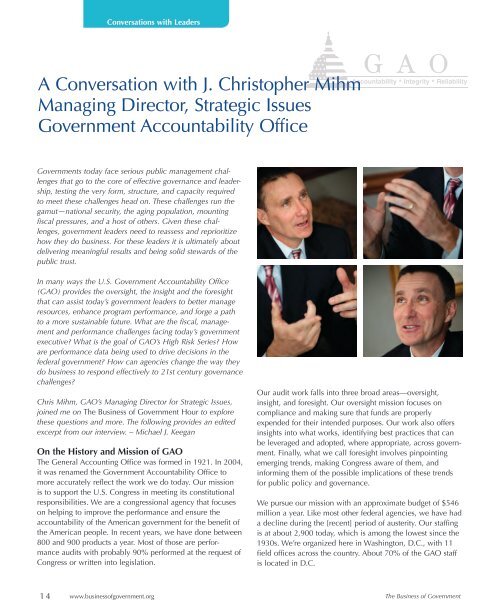1hmPUyl
1hmPUyl
1hmPUyl
Create successful ePaper yourself
Turn your PDF publications into a flip-book with our unique Google optimized e-Paper software.
Conversations with Leaders<br />
A Conversation with J. Christopher Mihm<br />
Managing Director, Strategic Issues<br />
Government Accountability Office<br />
Governments today face serious public management challenges<br />
that go to the core of effective governance and leadership,<br />
testing the very form, structure, and capacity required<br />
to meet these challenges head on. These challenges run the<br />
gamut—national security, the aging population, mounting<br />
fiscal pressures, and a host of others. Given these challenges,<br />
government leaders need to reassess and reprioritize<br />
how they do business. For these leaders it is ultimately about<br />
delivering meaningful results and being solid stewards of the<br />
public trust.<br />
In many ways the U.S. Government Accountability Office<br />
(GAO) provides the oversight, the insight and the foresight<br />
that can assist today’s government leaders to better manage<br />
resources, enhance program performance, and forge a path<br />
to a more sustainable future. What are the fiscal, management<br />
and performance challenges facing today’s government<br />
executive? What is the goal of GAO’s High Risk Series? How<br />
are performance data being used to drive decisions in the<br />
federal government? How can agencies change the way they<br />
do business to respond effectively to 21st century governance<br />
challenges?<br />
Chris Mihm, GAO’s Managing Director for Strategic Issues,<br />
joined me on The Business of Government Hour to explore<br />
these questions and more. The following provides an edited<br />
excerpt from our interview. – Michael J. Keegan<br />
On the History and Mission of GAO<br />
The General Accounting Office was formed in 1921. In 2004,<br />
it was renamed the Government Accountability Office to<br />
more accurately reflect the work we do today. Our mission<br />
is to support the U.S. Congress in meeting its constitutional<br />
responsibilities. We are a congressional agency that focuses<br />
on helping to improve the performance and ensure the<br />
accountability of the American government for the benefit of<br />
the American people. In recent years, we have done between<br />
800 and 900 products a year. Most of those are performance<br />
audits with probably 90% performed at the request of<br />
Congress or written into legislation.<br />
Our audit work falls into three broad areas—oversight,<br />
insight, and foresight. Our oversight mission focuses on<br />
compliance and making sure that funds are properly<br />
expended for their intended purposes. Our work also offers<br />
insights into what works, identifying best practices that can<br />
be leveraged and adopted, where appropriate, across government.<br />
Finally, what we call foresight involves pinpointing<br />
emerging trends, making Congress aware of them, and<br />
informing them of the possible implications of these trends<br />
for public policy and governance.<br />
We pursue our mission with an approximate budget of $546<br />
million a year. Like most other federal agencies, we have had<br />
a decline during the [recent] period of austerity. Our staffing<br />
is at about 2,900 today, which is among the lowest since the<br />
1930s. We’re organized here in Washington, D.C., with 11<br />
field offices across the country. About 70% of the GAO staff<br />
is located in D.C.<br />
14<br />
www.businessofgovernment.org<br />
The Business of Government


